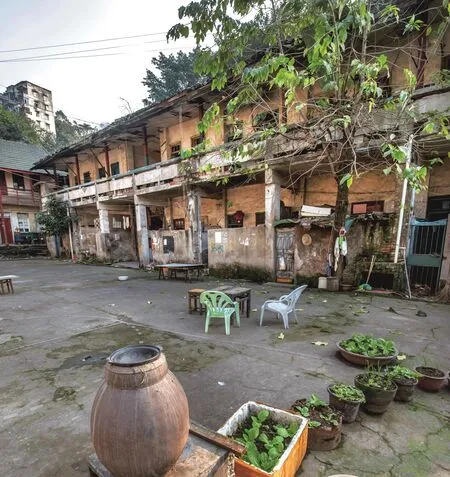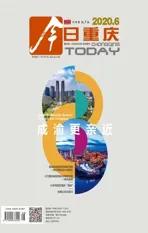战时重庆“中国好莱坞”
2017-07-05陈科龙刘汪洋
◇ 文|本刊记者 陈科龙 图| 刘汪洋
战时重庆“中国好莱坞”
◇ 文|本刊记者 陈科龙 图| 刘汪洋

五月末,一场淅沥的小雨浇灭了重庆的艳阳,南滨路玄坛庙背后,一条弯曲坎坷的老巷子笼罩在缥缈烟雨中。老巷子名唤“黄家巷”,雨巷两旁青砖高墙森然,并排立在山腰的几幢老式洋楼和民国建筑错落有致,透出浓郁的中西合璧式气质。零星的“黄锡滋产业”标志牌,分明在宣示它们曾经的主人。

The burning sun was extinguished by the light rain in the end of May in Chongqing. Behind Xuantan Temple in Nanbin Road, a winding rugged old alley called Huangjia Alley was shrouded in the misty rain, which was fl anked by lofty grey-brick walls. Several old- and western-style buildings and architecture built during the period of the Republic of China were in picturesque order, standing side by side on the hillside, where Chinese and Western styles were perfectly integrated. Fragmentary signs on them saying “Huang Xizi Property”declared their past owners

主人是位传奇巨贾The Owner, a Legendary Tycoon
黄家巷那些经年被风雨侵蚀的老式洋楼和民国建筑,跟一个叫黄锡滋的重庆人关系密切。清末光绪九年(公元1883年),黄锡滋出生在重庆的名门望族黄氏家族。28岁那年,他凭借祖辈留下的10万两白银,先后创办了天锡生和福兴玉两家盐号。灵活的商业头脑,让他很快跻身重庆四大盐商行列。
生意越做越大,黄锡滋开办了更多“天”字号商铺,开始经营糖、桐油、布匹、棉纱、油盐、山货等大宗批发业务及进出口贸易。为在物流环节胜出,黄锡滋又创办了福记航运部,并购置了3艘货轮。上世纪二三十年代,盗匪横行,军阀割据。考虑到安全因素,1929年,黄锡滋与法商永兴洋行合作成立了中法合资的“聚福洋行”。事实上,法国人一分钱也没出,黄锡滋每年还要送给法国人3万两银子,作为“挂旗费”。在法国人庇护下,黄锡滋靠“聚福洋行”敛财无数,白银积累最高达到五百万两,成为当时重庆屈指可数的巨贾。
此后,黄锡滋依托南岸区玄坛庙后的山地置地建房,修了别墅,建了中式瓦房宅院5个、西式楼房两幢,并在此运营航运公司。自此,这个原名为薄刀岭的山城小巷,因黄锡滋而改称“黄家巷”,黄锡滋也在市井历史中留下了传世之名。
Those buildings in Huangjia Alley, which underwent the erosion by wind and rain, are closely related to Huang Xizi from Chongqing. In the reign of Guangxu in the late Qing Dynasty (1883 A.D.), Huang Xizi was born with a silver spoon in his month. His family was illustrious in Chongqing back then. At the age of 28, he started his salt shops “Tian Xi Sheng” and “Fu Xing Yu”with the 10,000 silver dollars (about 20 million yuan)inherited from his ancestors. With a nose for business opportunities, he quickly became one of the four most successful salt dealers.
With the business expanding, Huang Xizi opened more shops whose names started from the Chinese character “Tian” to do both wholesaling and import and export. His shops sold sugar, tung oil, cloth, cotton yarn,oil, salt, and mountain products. In order to gain competitive edges in logistics, the businessman set up Fu Ji shipping department, and purchased three cargo ships.In the 1920s and 1930s, vices and violence by bandits went rampant, and the country was torn by warlordism,with each warlord dominating a region. In the year of 1929, for the sake of safety, Huang Xizi founded a Sino-French joint venture“Ju Fu Yang Hang” with French enterprise “Yong Xing Yang Hang”. As a matter of fact,the Frenchmen did not offer a cent, while the Chinese merchant had to give them 30,000 silver dollars every year so his businesses could be protected by them. He earned a large fortune with his “Ju Fu Yang Hang”– as much as 5,000,000 silver dollars, thus becoming one of the few tycoons in Chongqing.
Later on, Huang Xizi had his houses constructed in the mountain area behind Xuantan Temple in Nan’an District. Villas, five Chinese-style tile-roofed houses with courtyards, and two western-style buildings were constructed, and his shipping companies were operated there. As a result, the place, Bodaoling Valley, was named after Huang as Huangjia Valley, and his story went down in history.
黄家巷别墅曾为避暑天堂Villas in Huangjia Alley:a Paradise Away from the Summer Heat
早年,黄锡滋及家人住在现渝中区解放碑一带,位于黄家巷的别墅实为黄家人的避暑天堂。每年夏天,黄锡滋都会就带着家人过江到南岸避暑。黄家的别墅花园由一栋主楼和裙楼组成,面积宽广,还有五六个小院儿,黄家人住在主楼里,小院儿则给亲戚朋友们住。
主楼为一楼一底砖木结构,面朝长江,是一幢能看见长江、嘉陵江、渝中半岛和江北城的半圆形挑楼。黄锡滋夫妇住一楼,儿孙们则住二楼,一楼还有客厅和饭厅,厨房便安置在离主楼最近的裙楼,保姆和佣人也住裙楼内。为加强防御,黄锡滋在此修筑了青砖围墙,用条石砌成长50多米、高4米的堡坎。枝繁叶茂的黄桷树从堡坎石缝中长出,形成了独特的山城景观。
黄家巷位于坡上坎下的街巷空间,建筑风格就着山势变化,讲究几进几横、院中有院、院中套院、栋栋相连,既没有内敛的骄矜,也没封闭的府第式建筑。在这些建筑里,分布在门坊、天井、墙角石、串梁、柱基上的市井木雕,描刻着龙凤瑞兽、花鸟山水和戏曲演义。
黄家花园不仅是黄家避暑之地,也曾是一家人的避难之所。抗战时期,重庆也难免战火。南岸相对来说比较安全,黄锡滋一家人便在此地躲避轰炸。主楼的厨房后面挖有一个防空洞,只要一响起空袭警报,一家人就躲进防空洞,并接纳周围邻里到这里躲避。
In early years, the Huang family lived in Jiefangbei in Yuzhong District, while they went to their villas in Huangjia Alley to escape the summer heat. Huang Xiziwould cross the river to Nan’an District with his family members to escape the scorching sun every year.Covering a wide area, these villas were composed by a main building, podiums, and fi ve or six courtyards. The Huangs lived in the main building, while their relatives and friend in the courtyards.

The main building was a semicircle wood-brick structure facing the Yangtse River, from which the Yangtse River, Jialing River, Yuzhong Peninsula, and Jiangbei District could be seen. Huang Xizi and his wife lived on the fi rst fl oor where there were a living room and a dining room, their children and grandchildren on the second fl oor, and nurses and servants in the podium,which was near the main building and had a kitchen. In order to enhance the safety protection, grey-brick walls and 50 meters long, 4 meters high fortresses of chipped ashlar were built there. Luxuriant ficus virenses grew from the stone cracks in the fortresses, forming a unique scene which characterized the mountain city of Chongqing.
Located between the slopy paths and stairs,Huangjia Alley bore an architectural style attending to mountain features. Neglecting neither the introvert- nor the closed-style, it attached importance to the layout, the feature of yard within yard and the connection among buildings. The wood planks, carved with dragon and phoenix, fl owers and birds, and drama scenes, were decorated on doors, courtyards, cornerstones, string beams and plinths.
Huang’s garden was not only a summer courtyard but also a sanctuary for the family of Huang. During the period of the War of Resistance against Japan, Chongqing hardly could escape the warfare. Luckily, it was relatively safer in Nan’an District where the family hid to avoid bombardment. Behind the kitchen of the main building was an air-raid shelter. The moment the air-raidalarm rang, they would hide in the shelter which accommodated their neighbors as well.
一个战时的“中国好莱坞”“The Hollywood of China” in Wartime
1937年底,中央电影制片厂内迁至渝,并向黄锡滋租赁一幢别墅作为场址。别墅原房顶上盖的是琉璃瓦,内饰豪华,有仿西洋式的壁炉、木地板、地毯,用料讲究,与周围建筑相比,气派时尚。内间还设有摄影棚、剪接室、洗片室等。
被誉为话剧界“四大名旦”之一的白杨,当时居住在黄家巷6号的一栋两层楼房。楼房由青砖砌成,柏木地板,四方小院,门楣上书“嫣庐”二字,至今清晰可辨。在重庆8年时间,她接触到斯坦尼表演理论,开拓了艺术视野,加强了表演技巧探索和追求。
中央电影制片厂在此运作近8年。当时,国民党中央宣传部电影管理处处长罗学濂任场长,汇聚了众多优秀的编导、戏剧家和电影家,如史东山、沈西苓、陶金、赵丹、陈白尘、吴祖光、老舍、赵丹、王人美、蝴蝶、白杨、张瑞芳、金焰、黄宗江等,共计出品电影77部,被誉为战时的 “中国好莱坞”。
受条件限制,中央电影制片厂在此制作的影片多以纪录片为主,较为出名的有《东战场》《克复台儿庄》《重庆防空》《活跃的西线》等。故事片则仅有《孤城喋血》《中华儿女》《北战场精忠录》《长空万里》《青年中国》等5部,其中的《中华儿女》曾获捷克斯洛伐克第5届卡罗维•发利国际电影节自由斗争奖,是中国最早获国际荣誉的电影之一。
1940年,黄锡滋病故,传奇巨贾一生就此画上句号,曾煊赫一时的黄家产业也逐渐走向凋亡。如今,黄家巷的私家别墅也早已没了往日光彩,青砖黛瓦间,只余下寂寥的建筑躯壳。回望,黄家巷的斜阳草树,寻常阡陌,还有日渐老去的旧瓦残墙,似乎一直在诉说着一段曾经的岁月。
At the end of the 1937, the Central Film Studio moved to Chongqing and rent a villa of Huang Xizi as the studio site. The roof of the villa was originally constructed with glazed tiles, and the inside was luxuriously decorated with a western-style fireplace, wooden floor and carpets. The choice materials won out over neighboring buildings with its grand and stylish features.Within the building, a photo studio, a cutting room and a fi lming room were available.
Bai Yang, one of the four famous female characters in drama, lived in a two-storey building at No. 6 Huangjia Alley. This building is a quadrangle structure built with grey bricks, fl oored with cypress boards and decorated with a plaque on the door lintel written “嫣庐”(the cottage of a beauty) which is visible to this day. For eight years in Chongqing, Bai Yang learned the Stanislavski System which helped she broaden her artistic horizons and explore and strengthen her acting skills.
The Central Film Studio has operated here for eight years when Luo Xuelian, Commissioner for Film Administration of the Publicity Department of the Central Committee of the Kuomintang, was appointed as head of the studio. The studio brought together a number of talented directors, dramatists, film actors such as Shi Dongshan, Shen Xiling, Tao Jin, Zhao Dan, Chen Baichen, Wu Zuguang, Lao She, Wang Renmei, Hu Die, Bai Yang, Zhang Ruifang, Jin Yan, Huang Zongjiang, etc. Having produced 77 films in total during the wartime, the studio was hailed as “the Hollywood of China”.
Limited by the wartime conditions, the films produced by the Central Film Studio were mainly documentaries, some well-known ones such as The East Battlefield, Retake Taierzhuang, Chongqing Air Defense,and The Active Western Front. Feature fi lms produced were only Death and Glory in Changde, Chinese People,Heroes of the Northern Battle fi eld, Wings of China and Young China. Among them, the Chinese People, which won the Struggle for Freedom Award of the 5th Karlovy Vary International Film Festival in Czech Republic, was the fi rst Chinese fi lm achieving an international fame.
In 1940, as Huang Xizi succumbed to an illness,the story of a legendary tycoon came to an end, and his spectacular industry was on the decline. Now, the private villa on Huangjia Valley has lost its luster, leaving the solitary shell of grey bricks and black tiles. The setting sun slanting through grass and leaves, crisscross paths skirting the fi eld and decaying walls and tiles falling into ruin, all the scenes seem to be telling a story of the good old days.
“The Hollywood of China” in Chongqing during the War Years
Article/ Chen Kelong Pictures/ Liu Wangyang
